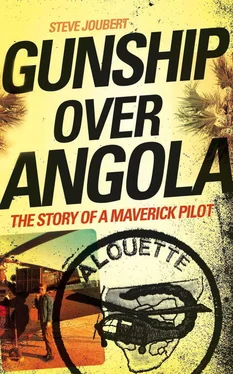They were no more than a few hundred feet above the ground when the air around them suddenly erupted with hundreds of small explosions originating from Russian-made ZSU 23-4 anti-aircraft guns. From our vantage point in the other six gunships that had just landed, we could clearly see that they were in a lot of trouble. Their chances of surviving the heavy barrage seemed decidedly small.
But both pilots instinctively dived for the cover of the vegetation as the trail of radar-guided anti-aircraft fire followed them right down to the tops of the trees. In fact, the tail boom of one of the two choppers hit the trees while evading the lethal fire, but the pilot still managed to maintain control of his aircraft.
No one argued when, minutes later, all choppers, Alos and Pumas alike, were instructed to get the hell out of Cuamato and head for a patch of land around ten kilometres to the east, which would serve as a temporary HAA until a better course of action could be formulated. At the time, I could not recall any occasion when enemy activity had forced the SADF to leave anywhere it had claimed as its base of operations, and a feeling of great disquiet took root in my belly.
We reached the temporary HAA without further incident and took stock of the situation.
At around lunchtime on the same day, a 32 Battalion patrol radioed that they were holed up, resting through the heat of the day, in a thick patch of bush on the edge of a shona around 15 kilometres northeast of our position, and that they could hear the sounds of a convoy of enemy vehicles coming in their direction, obviously searching for them.
Six gunships were immediately scrambled, with me at the rear as tail-end-Charlie. At the last possible moment before I took off, the OC of 32 Battalion, Commandant Deon ‘Jelly babes’ Ferreira, jumped into my aircraft and sat on the floor in the front left of the Alo, insisting that I allow him to tag along for the anticipated ‘turkey shoot’.
On the approach to the imminent contact I remember being quite excited at the prospect of taking on a convoy of vehicles, given my previous experience of the tanker along the Kunene River. As we closed in on the target, the leader of the 32 Battalion patrol, observing events from his refuge on the ground, whispered on the radio that he could clearly see the vehicles, which were now stopped on the edge of the shona , 200 metres from his position.
With around two kilometres to go to the target, the pilot leading our gunship formation pitched the nose of his chopper upwards and began a right-hand climbing turn. The rest of us strung out behind him to form a left-orbit circle around the target vehicles, which I could clearly see as soon as my gunship cleared the tops of the trees.
I was climbing through around 130 metres above the trees when the leader of the army patrol concealed in the bush alongside the shona suddenly broke radio silence and shouted, the anguish in his voice rising with each word, ‘They’ve taken the tarpaulins off the back of the trucks. Shit. They’ve got missiles. Gunships, get the fuck out of here!’
I had no time to react before the ground-to-air SAM-7 missiles started to streak away from the launchers around the GAZ trucks, and great clouds of white smoke from the ignition of the rocket motors rapidly obscured my view of the vehicles.
For a moment, I was mesmerised by the activity on the ground, and the gravity of the situation had not yet dawned on me when the leader of our formation shouted, ‘Steve, get down on the trees, you dumb idiot, or you will be shot down!’
Of the 17 SAM-7s fired at our formation in less than 20 seconds, 16 of them, failing to lock on to a target, spiralled off harmlessly into the sky.
The remaining missile, however, probably fired by a more patient operator, streaked directly for my gunship, probably because I had reacted far too slowly to avoid it. When I saw it heading for me, my perspective somehow shifted from sitting in the pilot’s seat of the Alo to watching the events unfold from a position outside the aircraft, about five metres in front and to the right of the nose.
In my mind’s eye, I can still see the missile leaving the launcher tube near the back of the truck.
I see the moment, just a split second later, when the rocket motor ignites and a great cloud of white smoke forms behind the missile.
I see the approaching metallic tube, with its staring glass eye, waggle slightly as it searches for an infrared light source on my gunship.
I see it nod its head almost imperceptibly as it locks onto a shiny spot on the Alo.
By this time, the missile was already travelling at over a thousand kilometres per hour, but in that super-stressed situation, it seemed to be crawling towards me in ultra slow motion. Strangely, I also knew that I had more than adequate time to avoid it.
When the missile was about 300 metres away, some heightened instinct urged me to bank the Alo. I just knew, at that precise moment, thanks forever to my overworked guardian angel, that the incoming projectile was locked on to the Alo’s shiny left-hand main wheel shock strut extension, and that by pointing the shock strut directly at the supersonic missile, the shiny bit would be screened from the infrared sensor.
This action broke the lock-on, and although the missile continued towards us, it suddenly seemed to become confused and turn slightly to the left, which meant it passed just in front of the gunship, around six metres away. As it rushed past, I became entranced by its little guidance vanes shimmering in the supersonic airflow and its tiny movements as it sought vainly for a target to obliterate.
Then it disappeared. From the time the missile was fired to when it disappeared after passing my gunship, no more than six seconds had elapsed.
Back at treetop level, in the immediate aftermath of my close encounter with the SAM, the gunship formation regrouped and we took a decision by radio to resume the attack on the convoy, but with modified tactics. We agreed to form the normal wide attack circle around the target, but instead of going in at 600 to 800 feet (200 to 250 metres) above the ground, we would do so at treetop level. We knew this was outside the operating parameters of the SAM-7, and would make redundant any further use of missiles by the enemy.
The convoy was parked in the open at the eastern edge of the shona , which was surrounded by thick bush. Our plan involved each gunship, flying one behind the other and around ten seconds apart, to cut across the western side of the shona around 200 metres away from the convoy at low level. This would create a clear field of fire for around five to eight seconds, between exiting the thick bush on the northern side and regaining the cover of the bush on the southern side, for each of the 20 mm cannons firing from the left-hand sides of the Alos.
Done correctly, the bad guys in the missile-equipped GAZ trucks would be subjected to an extremely unpleasant and almost continuous stream of 20 mm cannon fire for around 60 seconds each time our formation passed by.
As tail-end-Charlie, this arrangement made it likely that I would experience the least hostile response from the convoy, provided that the damage caused by the first five gunships was effective. Conversely, if their damage was light, the enemy would be best prepared for my arrival when I wafted by at the rear of the formation.
As we were lining up a couple of kilometres north of the shona to start the attack, high above us, at an altitude of around 10 000 feet (3 000 metres), was an entity we all knew as Telstar. Flying in a light reconnaissance aircraft called a Bosbok, Telstar’s role was to monitor activity on the battlefield. Whenever contact between SADF forces and anyone else was under way or imminent, Telstar would relay details of the developing situation to the brass in the SADF war room in Oshakati.
Читать дальше












